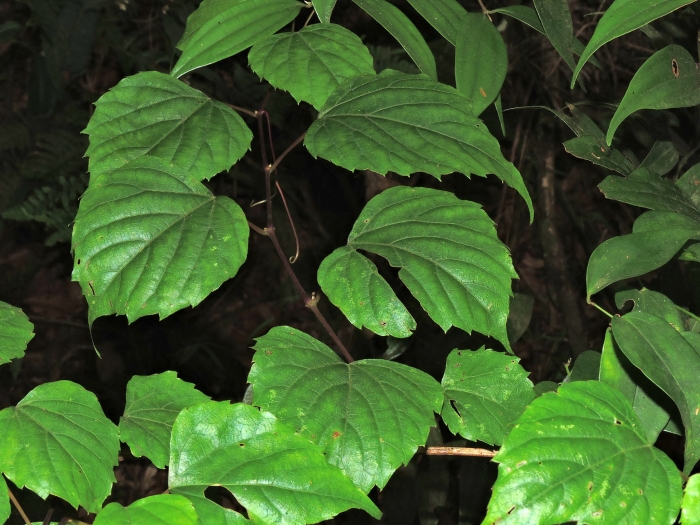Twisting Grape
(Vitis flexuosa)
Twisting Grape (Vitis flexuosa)
/
/

Jacy Chen
CC BY 4.0
Image By:
Jacy Chen
Recorded By:
Copyright:
CC BY 4.0
Copyright Notice:
Photo by: Jacy Chen | License Type: CC BY 4.0 | License URL: http://creativecommons.org/licenses/by/4.0/ | Rights Holder: Jacy Chen | Publisher: iNaturalist | Date Created: 2018-06-02T12:13:01-07:00 |












Estimated Native Range
Summary
Vitis flexuosa, commonly known as the Twisting Grape, is a deciduous liana native to a variety of habitats including forest margins, valley woodlands, and along riverbanks in South and East Asia. It is well-adapted to both tropical and temperate climates within its native range, which includes countries such as China, Korea, and Japan. This vine can grow quite long, with stems that can reach up to 10 meters in length, and it climbs using tendrils. The leaves of Vitis flexuosa are simple, alternate, and often lobed, with a heart-shaped base and a toothed margin. It produces small greenish flowers that are not particularly showy, followed by black-purple berries that are attractive to wildlife.
The Twisting Grape is valued for its ability to cover structures quickly, providing shade and greenery. It is used for ornamental purposes in gardens and landscapes, and can be trained over pergolas, fences, and walls. In cultivation, it requires a support structure to climb on. It prefers well-drained soils, tolerates a range of soil types, and does best with regular watering, especially in dry periods. While it can grow in partial shade, it thrives in full sun, which encourages better fruiting. Gardeners should be aware that this species can become problematic if not managed properly, as it has the potential to spread aggressively and outcompete native vegetation.CC BY-SA 4.0
The Twisting Grape is valued for its ability to cover structures quickly, providing shade and greenery. It is used for ornamental purposes in gardens and landscapes, and can be trained over pergolas, fences, and walls. In cultivation, it requires a support structure to climb on. It prefers well-drained soils, tolerates a range of soil types, and does best with regular watering, especially in dry periods. While it can grow in partial shade, it thrives in full sun, which encourages better fruiting. Gardeners should be aware that this species can become problematic if not managed properly, as it has the potential to spread aggressively and outcompete native vegetation.CC BY-SA 4.0
Plant Description
- Plant Type: Vines
- Height: 20-30 feet
- Width: 3-6 feet
- Growth Rate: Rapid
- Flower Color: Green
- Flowering Season: Spring
- Leaf Retention: Deciduous
Growth Requirements
- Sun: Full Sun, Part Shade
- Water: Medium
- Drainage: Fast, Medium
Common Uses
Edible*Disclaimer: Easyscape's listed plant edibility is for informational use. Always verify the safety and proper identification of any plant before consumption., Water Garden
Natural Habitat
Forest margins, valley woodlands, and riverbanks in East and South Asia
Other Names
Common Names: Twisted Grapevine , Creeping Grape , Bamboo-Leaf Grape
Scientific Names: Vitis flexuosa , Vitis cavaleriei , Vitis cinerea , Vitis flexuosa f. typica , Vitis flexuosa subsp. chinensis , Vitis flexuosa subsp. wallichii , Vitis flexuosa var. chinensis , Vitis flexuosa var. wallichii , Vitis indica , Vitis parvifolia
GBIF Accepted Name: